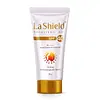What's inside
What's inside
 Key Ingredients
Key Ingredients

 Benefits
Benefits

No benefits
 Concerns
Concerns

 Ingredients Side-by-side
Ingredients Side-by-side

Cyclopentasiloxane
EmollientDimethicone Crosspolymer
Emulsion StabilisingEthylhexyl Methoxycinnamate
UV AbsorberOctyldodecanol
EmollientDivinyldimethicone/Dimethicone/Phenylsilsesquioxane Crosspolymer
Bis-Ethylhexyloxyphenol Methoxyphenyl Triazine
Skin ConditioningDiethylamino Hydroxybenzoyl Hexyl Benzoate
UV FilterTalc
AbrasiveUndecylenoyl Phenylalanine
Skin ConditioningTitanium Dioxide
Cosmetic ColorantSilicon
AbrasiveColloidal Silver
AntimicrobialParfum
MaskingDimethicone
EmollientCyclopentasiloxane, Dimethicone Crosspolymer, Ethylhexyl Methoxycinnamate, Octyldodecanol, Divinyldimethicone/Dimethicone/Phenylsilsesquioxane Crosspolymer, Bis-Ethylhexyloxyphenol Methoxyphenyl Triazine, Diethylamino Hydroxybenzoyl Hexyl Benzoate, Talc, Undecylenoyl Phenylalanine, Titanium Dioxide, Silicon, Colloidal Silver, Parfum, Dimethicone
Water
Skin ConditioningC12-15 Alkyl Benzoate
AntimicrobialEthylhexyl Methoxycinnamate
UV AbsorberDimethicone
EmollientSodium Acrylates Copolymer
Butyl Methoxydibenzoylmethane
UV AbsorberGlycerin
HumectantBenzophenone-3
UV AbsorberButylene Glycol
HumectantPhenoxyethanol
PreservativeAloe Barbadensis Leaf Juice
Skin ConditioningLecithin
EmollientSodium Levulinate
Skin ConditioningXylitol
HumectantGlucose
HumectantPropylene Glycol
HumectantPhospholipids
Skin ConditioningAnhydroxylitol
HumectantGlyceryl Stearate
EmollientAllantoin
Skin ConditioningTocopheryl Acetate
AntioxidantOxothiazolidine
Skin ProtectingVaccinium Corymbosum Seed
AbrasiveVaccinium Angustifolium Fruit Extract
Skin ProtectingCitrus Paradisi Fruit Extract
Skin ConditioningPhoenix Dactylifera Seed Extract
MoisturisingGlyceryl Glucoside
HumectantZinc Oxide
Cosmetic ColorantCyclopentasiloxane
EmollientCarica Papaya Fruit Extract
Skin ConditioningPEG-10 Dimethicone
Skin ConditioningCeramide AP
Skin ConditioningHelianthus Annuus Seed Oil
EmollientAscorbic Acid
AntioxidantHyaluronic Acid
HumectantC9-12 Alkane
SolventHydrogen Dimethicone
Titanium Dioxide
Cosmetic ColorantAluminum Hydroxide
EmollientPolyhydroxystearic Acid
EmulsifyingWater, C12-15 Alkyl Benzoate, Ethylhexyl Methoxycinnamate, Dimethicone, Sodium Acrylates Copolymer, Butyl Methoxydibenzoylmethane, Glycerin, Benzophenone-3, Butylene Glycol, Phenoxyethanol, Aloe Barbadensis Leaf Juice, Lecithin, Sodium Levulinate, Xylitol, Glucose, Propylene Glycol, Phospholipids, Anhydroxylitol, Glyceryl Stearate, Allantoin, Tocopheryl Acetate, Oxothiazolidine, Vaccinium Corymbosum Seed, Vaccinium Angustifolium Fruit Extract, Citrus Paradisi Fruit Extract, Phoenix Dactylifera Seed Extract, Glyceryl Glucoside, Zinc Oxide, Cyclopentasiloxane, Carica Papaya Fruit Extract, PEG-10 Dimethicone, Ceramide AP, Helianthus Annuus Seed Oil, Ascorbic Acid, Hyaluronic Acid, C9-12 Alkane, Hydrogen Dimethicone, Titanium Dioxide, Aluminum Hydroxide, Polyhydroxystearic Acid
Ingredients Explained
These ingredients are found in both products.
Ingredients higher up in an ingredient list are typically present in a larger amount.
Cyclopentasiloxane, or D5, is a silicone used to improve texture of products and trap moisture.
D5 is considered lightweight and volatile. Volatile means it evaporates quickly after application. Once evaporated, D5 leaves a thin barrier that helps keep skin hydrated.
It is also an emollient. Emollients help soften the skin and prevent water loss. Silicones create a silky texture in products. D5 helps other ingredients become more spreadable.
Studies show D5 is safe to use in skincare products. We recommend speaking with a skincare professional if you have concerns.
Learn more about CyclopentasiloxaneDimethicone is a type of synthetic silicone created from natural materials such as quartz.
What it does:
Dimethicone comes in different viscosities:
Depending on the viscosity, dimethicone has different properties.
Ingredients lists don't always show which type is used, so we recommend reaching out to the brand if you have questions about the viscosity.
This ingredient is unlikely to cause irritation because it does not get absorbed into skin. However, people with silicone allergies should be careful about using this ingredient.
Note: Dimethicone may contribute to pilling. This is because it is not oil or water soluble, so pilling may occur when layered with products. When mixed with heavy oils in a formula, the outcome is also quite greasy.
Learn more about DimethiconeEthylhexyl Methoxycinnamate is an organic compound that provides UVB protection. It often goes by the more common name of octinoxate. It is created from methoxycinnamic acid and 2-ethylhexanol.
Ethylhexyl Methoxycinnamate absorbs UVB rays with wavelengths between 280-320 nm. UV absorbers protect your skin by using chemical reactions to convert UV rays into heat and energy.
UVB (290-320 nm) rays emit more energy than UVA rays. They are capable of damaging DNA, causing sunburns and are thought to be linked to skin cancer.
The state of Hawaii has banned sunscreens containing octinoxate due to its potential impact on coral reefs. More research is needed to bridge gaps in this research. The European Union allows higher levels of octinoxate in sunscreens than the US and Australia.
Ethylhexyl Methoxycinnamate is oil soluble. It is not stable and may lose efficacy when exposed to sunlight.
Learn more about Ethylhexyl MethoxycinnamateTitanium dioxide is a mineral UV filter widely used in sunscreens and cosmetics.
It is one of only two UV filters officially classified as “mineral” by regulatory agencies, the other being zinc oxide.
Titanium dioxide provides broad-spectrum protection mostly in the UVB and UVAII range, with some protection in the UVAI range.
While its UVA protection isn’t as strong as zinc oxide’s, the difference is minor.
A common myth is that mineral UV filters reflect UV light. However, modern research shows titanium dioxide absorbs UV radiation like chemical filters (~95% absorption & 5% reflection).
Thanks to its non-irritating nature, titanium dioxide is suitable for sensitive, acne-prone, or redness-prone skin. It is unlikely to cause "eye sting" like other sunscreen ingredients.
A major drawback of this ingredient is its white cast and thick texture. This is why mineral sunscreens often leave a white cast and are less cosmetically elegant than chemical/hybrid sunscreens.
To improve white cast and spreadability, micronized or nano-sized titanium dioxide is often used.
There are ongoing concerns surrounding nano-titanium oxide's impact on marine ecosystems.
There is no conclusive evidence that any form of titanium oxide (or any other sunscreen ingredients) will cause harm to marine ecosystems or coral reefs. The science is still developing but many consumers are keeping a close eye on this issue.
Please note, many destinations have reef-safety sunscreen rules. For instance, the U.S. Virgin Islands advises all visitors to use non-nano mineral sunscreens.
Nano mineral sunscreens once raised safety concerns about absorption into skin.
Extensive research has shown that they do not penetrate healthy or damaged skin; they remain safely on the surface and the top layer of dead skin (stratum corneum).
You'll likely find titanium dioxide bundled with alumina, silica, or dimethicone. These ingredients help make titanium dioxide highly photostable; this prevents it from interacting with other formula components under UV light.
Learn more about Titanium Dioxide